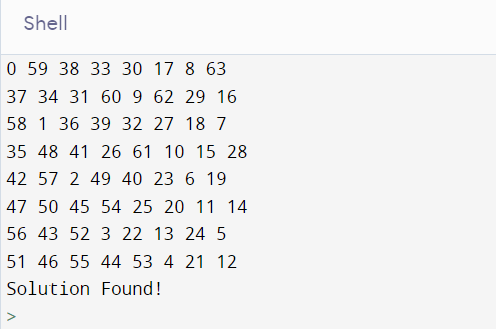Python Tutorial
Python OOPs
Python MySQL
Python MongoDB
Python SQLite
Python Questions
Plotly
Python Tkinter (GUI)
Python Web Blocker
Python MCQ
Related Tutorials
Python Programs
Knight Tour ProblemThe Knight's Tour problem is a classic problem in the field of computational mathematics and computer science. It is a puzzle where a chess knight is placed on an empty chess board and the goal is to move the knight to every square on the board exactly once without re-visiting any squares. The tour is considered closed if the knight ends on the square it started on. The problem can be solved using several different algorithms, including depth-first search, breadth-first search, and backtracking. The most famous algorithm used to solve the Knight's Tour problem is Warnsdorff's algorithm, which is based on the principle that the knight should always move to the square with the least number of available moves. The Knight's Tour problem has been proven to have no general solution, and it is known to be an NP-hard problem. However, solutions can be found for certain starting positions on the board. For example, if the knight starts on a square in the corner of the board, a solution can always be found. On the other hand, if the knight starts on a central square, a solution may not be possible. The Knight's Tour problem has many interesting variations such as:
The problem has many practical applications in computer science and mathematics, such as:
Overall, the Knight's Tour problem is a challenging problem that requires a combination of mathematical analysis, algorithmic design, and computational power to solve. One algorithm that can be used to solve the Knight's Tour problem is Warnsdorff's algorithm. The algorithm is based on the principle that the knight should always move to the square with the least number of available moves. The idea behind this is that by moving to a square with fewer options, the knight is less likely to get stuck at a dead end. The algorithm proceeds as follows: Step 1: Firstly, start at any square on the chess board. For example, we can start at the top-left corner (0,0). Step 2: Move the knight to an unvisited square with the fewest number of available moves. If there is a tie, choose any of the tied squares. For example, at the start position of (0,0), the knight has 2 available moves (1,2) and (2,1). We choose the square (1,2) to move to. Step 3:Mark the square as visited. It means that the square (1,2) is now marked as visited and the knight cannot move back to it. Step 4: Repeat steps 2 and 3 until all squares on the board have been visited. For example, from square (1,2), the knight can move to square (3,1) which is an unvisited square with the least number of available moves. Step 5: If all squares have been visited, the Knight's Tour is complete. If not, backtrack to the last square with an available move and continue the search. For example, if the knight reaches a point where it cannot move to any unvisited squares, it means that it has reached a dead end and the algorithm needs to backtrack to the last square with an available move. It's important to note that this algorithm is not guaranteed to find a solution for every starting position on the board, and it may get stuck in an infinite loop if the board is not completely connected. However, it can be used to find solutions for certain starting positions and can also be used as a basis for other, more advanced algorithms to solve the Knight's Tour problem. Also, there are different variationsto make the algorithm more efficient and faster, such as:
These are some of the ways to improve the algorithm and make it more efficient, but they are much more complex than the basic Warnsdorff algorithm.It is important to note that this algorithm is not guaranteed to find a solution for every starting position on the board, and it may get stuck in an infinite loop if the board is not completely connected. However, it can be used to find solutions for certain starting positions and can also be used as a basis for other, more advanced algorithms to solve the Knight's Tour problem. Python Code to implement it: Sample code in Python for the Knight's Tour problem using the backtracking algorithm: Output: 
The technique followed can be described as: If the Knight visits all the cells in the board, the solution gets printed. Otherwise:
Java implementation of the Knight's Tour problem using the backtracking algorithm: Output: 0 59 38 33 30 17 8 63 37 34 31 60 9 62 29 16 58 1 36 39 32 27 18 7 35 48 41 26 61 10 15 28 42 57 2 49 40 23 6 19 47 50 45 54 25 20 11 14 56 43 52 3 22 13 24 5 51 46 55 44 53 4 21 12 The function solveKT() checks if it is safe to move to a certain position on the chessboard; if so, it updates the knight's position and assigns the move number to that position on the chessboard. The Time Complexity can be given as: The worst running time is O(8^(N^2)) since there are N^2 Cells and we can choose from a maximum of 8 potential motions for each Cell. The algorithm implementation requires an Auxiliary Space of about O(N^2). This problem is an NP problem and has many possibilities, thus it may not have a solution for all cases, and also the time to find a solution will depend on the initial position of the knight and the chessboard size.
Next TopicSerialization in Python
|
 For Videos Join Our Youtube Channel: Join Now
For Videos Join Our Youtube Channel: Join Now
Feedback
- Send your Feedback to [email protected]
Help Others, Please Share










